inflation pressure FIAT TALENTO 2020 Owner handbook (in English)
[x] Cancel search | Manufacturer: FIAT, Model Year: 2020, Model line: TALENTO, Model: FIAT TALENTO 2020Pages: 236, PDF Size: 4.86 MB
Page 11 of 236
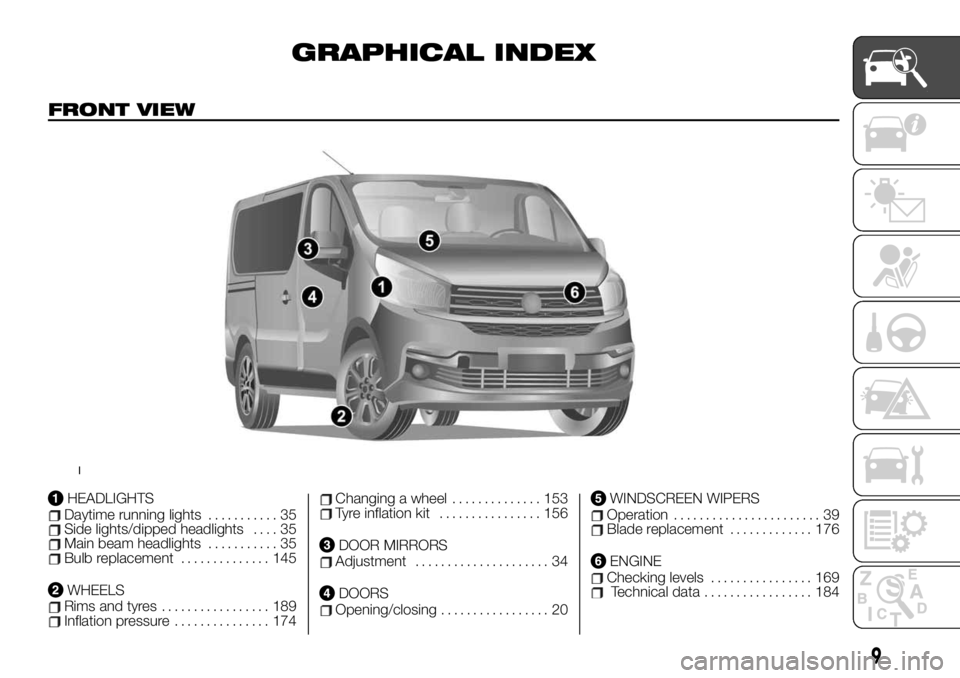
GRAPHICAL INDEX
FRONT VIEW
HEADLIGHTSDaytime running lights........... 35Side lights/dipped headlights.... 35Main beam headlights........... 35Bulb replacement.............. 145
WHEELSRims and tyres................. 189Inflation pressure............... 174
Changing a wheel.............. 153Tyre inflation kit................ 156
DOOR MIRRORSAdjustment..................... 34
DOORSOpening/closing................. 20
WINDSCREEN WIPERSOperation....................... 39Blade replacement............. 176
ENGINEChecking levels................ 169Technical data................. 184
1
9
Page 131 of 236
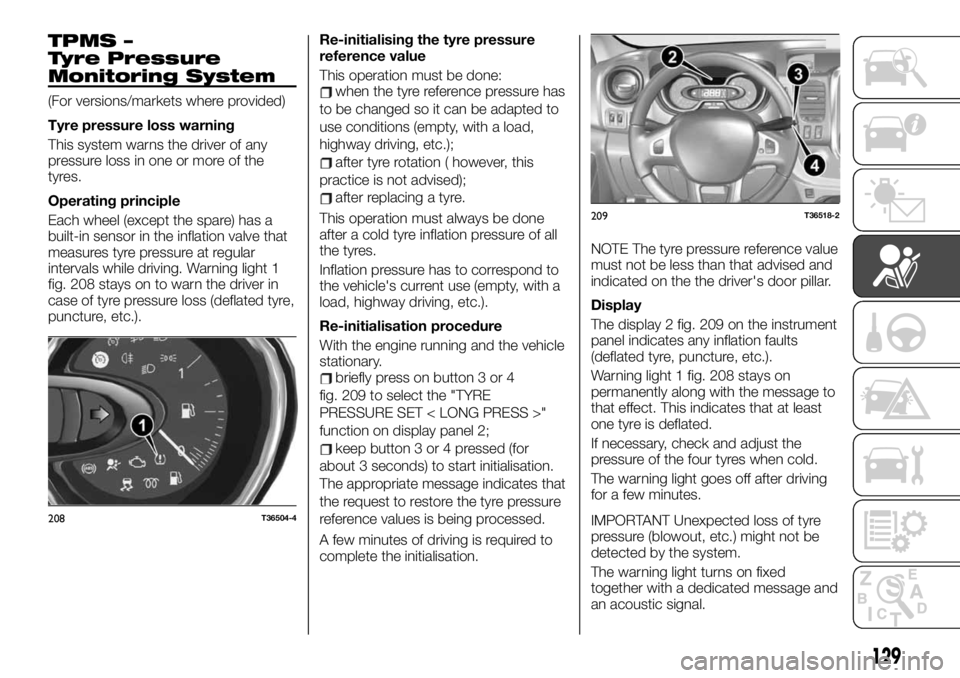
TPMS –
Tyre Pressure
Monitoring System
(For versions/markets where provided)
Tyre pressure loss warning
This system warns the driver of any
pressure loss in one or more of the
tyres.
Operating principle
Each wheel (except the spare) has a
built-in sensor in the inflation valve that
measures tyre pressure at regular
intervals while driving. Warning light 1
fig. 208 stays on to warn the driver in
case of tyre pressure loss (deflated tyre,
puncture, etc.).Re-initialising the tyre pressure
reference value
This operation must be done:when the tyre reference pressure has
to be changed so it can be adapted to
use conditions (empty, with a load,
highway driving, etc.);
after tyre rotation ( however, this
practice is not advised);
after replacing a tyre.
This operation must always be done
after a cold tyre inflation pressure of all
the tyres.
Inflation pressure has to correspond to
the vehicle's current use (empty, with a
load, highway driving, etc.).
Re-initialisation procedure
With the engine running and the vehicle
stationary.
briefly press on button 3 or 4
fig. 209 to select the "TYRE
PRESSURE SET < LONG PRESS >"
function on display panel 2;
keep button 3 or 4 pressed (for
about 3 seconds) to start initialisation.
The appropriate message indicates that
the request to restore the tyre pressure
reference values is being processed.
A few minutes of driving is required to
complete the initialisation.NOTE The tyre pressure reference value
must not be less than that advised and
indicated on the the driver's door pillar.
Display
The display 2 fig. 209 on the instrument
panel indicates any inflation faults
(deflated tyre, puncture, etc.).
Warning light 1 fig. 208 stays on
permanently along with the message to
that effect. This indicates that at least
one tyre is deflated.
If necessary, check and adjust the
pressure of the four tyres when cold.
The warning light goes off after driving
for a few minutes.
IMPORTANT Unexpected loss of tyre
pressure (blowout, etc.) might not be
detected by the system.
The warning light turns on fixed
together with a dedicated message and
an acoustic signal.
208T36504-4
209T36518-2
129
Page 132 of 236
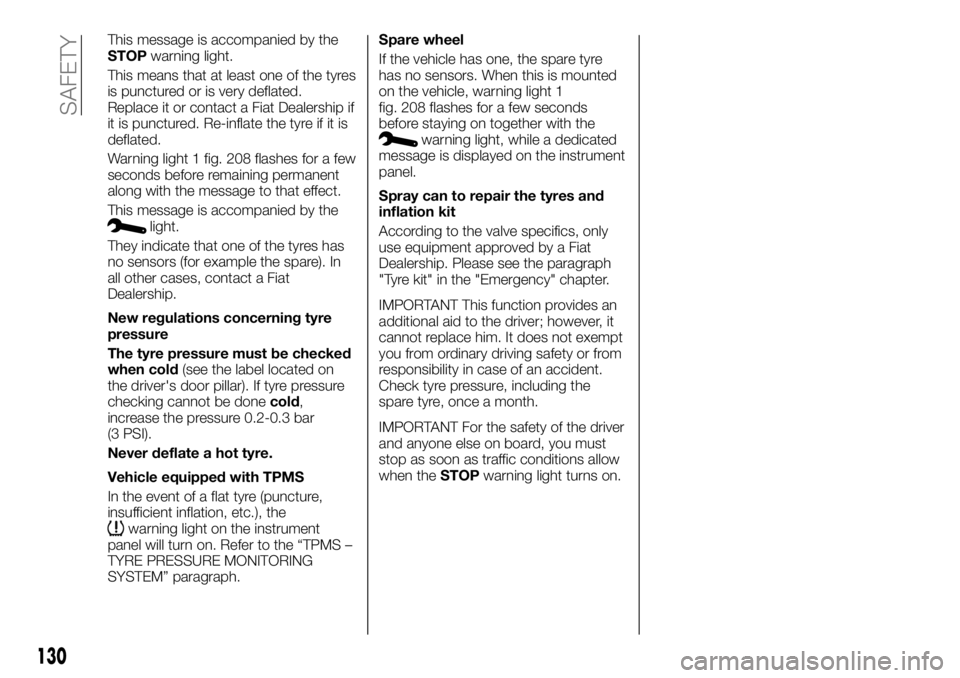
This message is accompanied by the
STOPwarning light.
This means that at least one of the tyres
is punctured or is very deflated.
Replace it or contact a Fiat Dealership if
it is punctured. Re-inflate the tyre if it is
deflated.
Warning light 1 fig. 208 flashes for a few
seconds before remaining permanent
along with the message to that effect.
This message is accompanied by the
light.
They indicate that one of the tyres has
no sensors (for example the spare). In
all other cases, contact a Fiat
Dealership.
New regulations concerning tyre
pressure
The tyre pressure must be checked
when cold(see the label located on
the driver's door pillar). If tyre pressure
checking cannot be donecold,
increase the pressure 0.2-0.3 bar
(3 PSI).
Never deflate a hot tyre.
Vehicle equipped with TPMS
In the event of a flat tyre (puncture,
insufficient inflation, etc.), the
warning light on the instrument
panel will turn on. Refer to the “TPMS –
TYRE PRESSURE MONITORING
SYSTEM” paragraph.Spare wheel
If the vehicle has one, the spare tyre
has no sensors. When this is mounted
on the vehicle, warning light 1
fig. 208 flashes for a few seconds
before staying on together with the
warning light, while a dedicated
message is displayed on the instrument
panel.
Spray can to repair the tyres and
inflation kit
According to the valve specifics, only
use equipment approved by a Fiat
Dealership. Please see the paragraph
"Tyre kit" in the "Emergency" chapter.
IMPORTANT This function provides an
additional aid to the driver; however, it
cannot replace him. It does not exempt
you from ordinary driving safety or from
responsibility in case of an accident.
Check tyre pressure, including the
spare tyre, once a month.
IMPORTANT For the safety of the driver
and anyone else on board, you must
stop as soon as traffic conditions allow
when theSTOPwarning light turns on.
130
SAFETY
Page 157 of 236
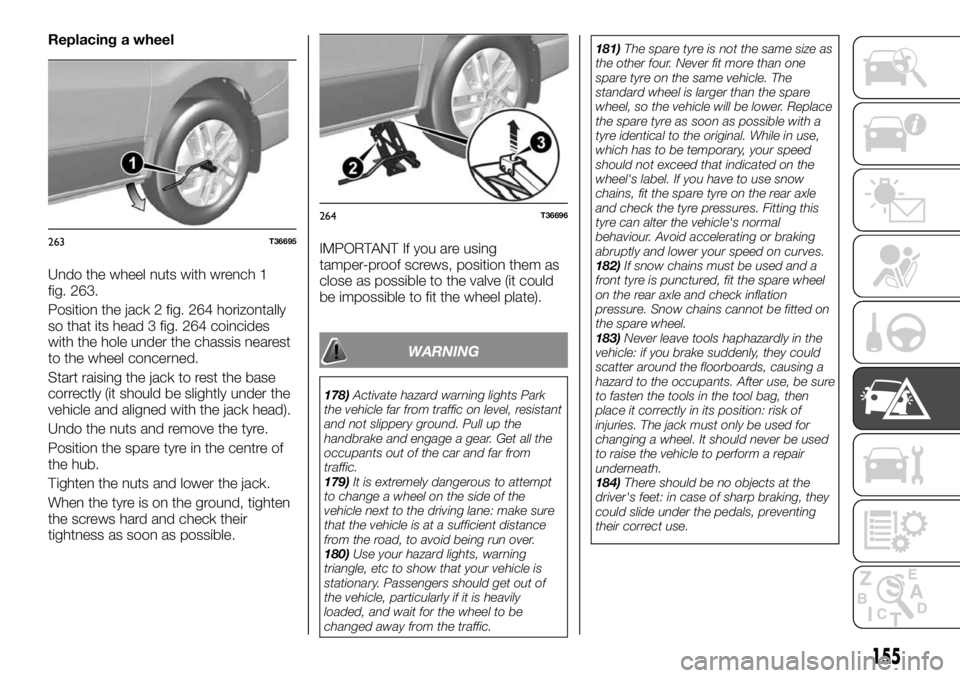
Replacing a wheel
Undo the wheel nuts with wrench 1
fig. 263.
Position the jack 2 fig. 264 horizontally
so that its head 3 fig. 264 coincides
with the hole under the chassis nearest
to the wheel concerned.
Start raising the jack to rest the base
correctly (it should be slightly under the
vehicle and aligned with the jack head).
Undo the nuts and remove the tyre.
Position the spare tyre in the centre of
the hub.
Tighten the nuts and lower the jack.
When the tyre is on the ground, tighten
the screws hard and check their
tightness as soon as possible.IMPORTANT If you are using
tamper-proof screws, position them as
close as possible to the valve (it could
be impossible to fit the wheel plate).
WARNING
178)Activate hazard warning lights Park
the vehicle far from traffic on level, resistant
and not slippery ground. Pull up the
handbrake and engage a gear. Get all the
occupants out of the car and far from
traffic.
179)It is extremely dangerous to attempt
to change a wheel on the side of the
vehicle next to the driving lane: make sure
that the vehicle is at a sufficient distance
from the road, to avoid being run over.
180)Use your hazard lights, warning
triangle, etc to show that your vehicle is
stationary. Passengers should get out of
the vehicle, particularly if it is heavily
loaded, and wait for the wheel to be
changed away from the traffic.181)The spare tyre is not the same size as
the other four. Never fit more than one
spare tyre on the same vehicle. The
standard wheel is larger than the spare
wheel, so the vehicle will be lower. Replace
the spare tyre as soon as possible with a
tyre identical to the original. While in use,
which has to be temporary, your speed
should not exceed that indicated on the
wheel's label. If you have to use snow
chains, fit the spare tyre on the rear axle
and check the tyre pressures. Fitting this
tyre can alter the vehicle's normal
behaviour. Avoid accelerating or braking
abruptly and lower your speed on curves.
182)If snow chains must be used and a
front tyre is punctured, fit the spare wheel
on the rear axle and check inflation
pressure. Snow chains cannot be fitted on
the spare wheel.
183)Never leave tools haphazardly in the
vehicle: if you brake suddenly, they could
scatter around the floorboards, causing a
hazard to the occupants. After use, be sure
to fasten the tools in the tool bag, then
place it correctly in its position: risk of
injuries. The jack must only be used for
changing a wheel. It should never be used
to raise the vehicle to perform a repair
underneath.
184)There should be no objects at the
driver's feet: in case of sharp braking, they
could slide under the pedals, preventing
their correct use.
263T36695
264T36696
155
Page 158 of 236
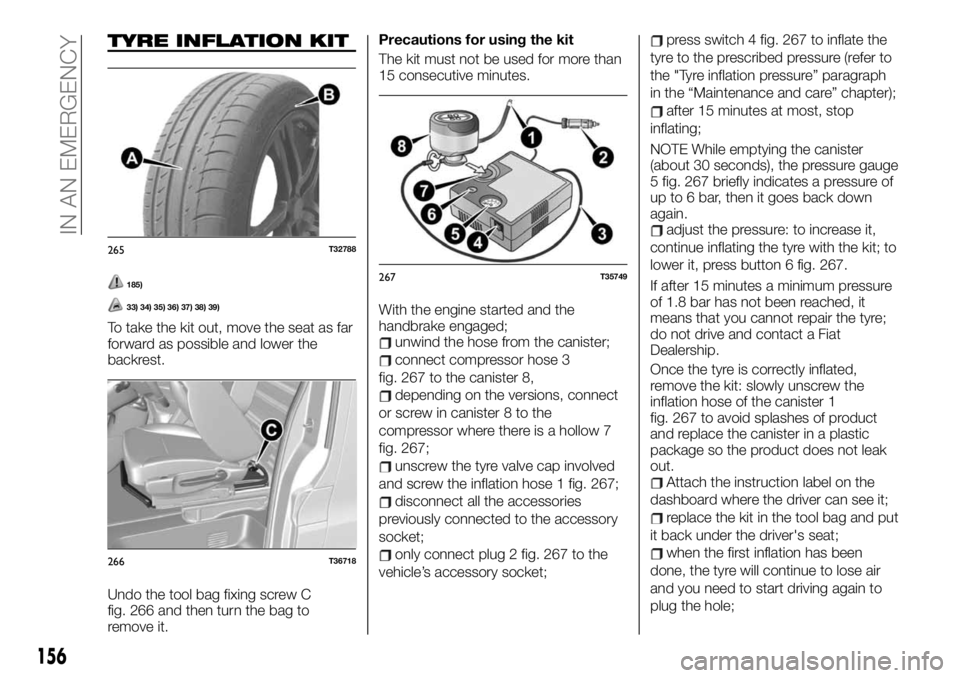
TYRE INFLATION KIT
185)
33) 34) 35) 36) 37) 38) 39)
To take the kit out, move the seat as far
forward as possible and lower the
backrest.
Undo the tool bag fixing screw C
fig. 266 and then turn the bag to
remove it.Precautions for using the kit
The kit must not be used for more than
15 consecutive minutes.
With the engine started and the
handbrake engaged;unwind the hose from the canister;
connect compressor hose 3
fig. 267 to the canister 8,
depending on the versions, connect
or screw in canister 8 to the
compressor where there is a hollow 7
fig. 267;
unscrew the tyre valve cap involved
and screw the inflation hose 1 fig. 267;
disconnect all the accessories
previously connected to the accessory
socket;
only connect plug 2 fig. 267 to the
vehicle’s accessory socket;
press switch 4 fig. 267 to inflate the
tyre to the prescribed pressure (refer to
the "Tyre inflation pressure” paragraph
in the “Maintenance and care” chapter);
after 15 minutes at most, stop
inflating;
NOTE While emptying the canister
(about 30 seconds), the pressure gauge
5 fig. 267 briefly indicates a pressure of
up to 6 bar, then it goes back down
again.
adjust the pressure: to increase it,
continue inflating the tyre with the kit; to
lower it, press button 6 fig. 267.
If after 15 minutes a minimum pressure
of 1.8 bar has not been reached, it
means that you cannot repair the tyre;
do not drive and contact a Fiat
Dealership.
Once the tyre is correctly inflated,
remove the kit: slowly unscrew the
inflation hose of the canister 1
fig. 267 to avoid splashes of product
and replace the canister in a plastic
package so the product does not leak
out.
Attach the instruction label on the
dashboard where the driver can see it;
replace the kit in the tool bag and put
it back under the driver's seat;
when the first inflation has been
done, the tyre will continue to lose air
and you need to start driving again to
plug the hole;
265T32788
266T36718
267T35749
156
IN AN EMERGENCY
Page 159 of 236
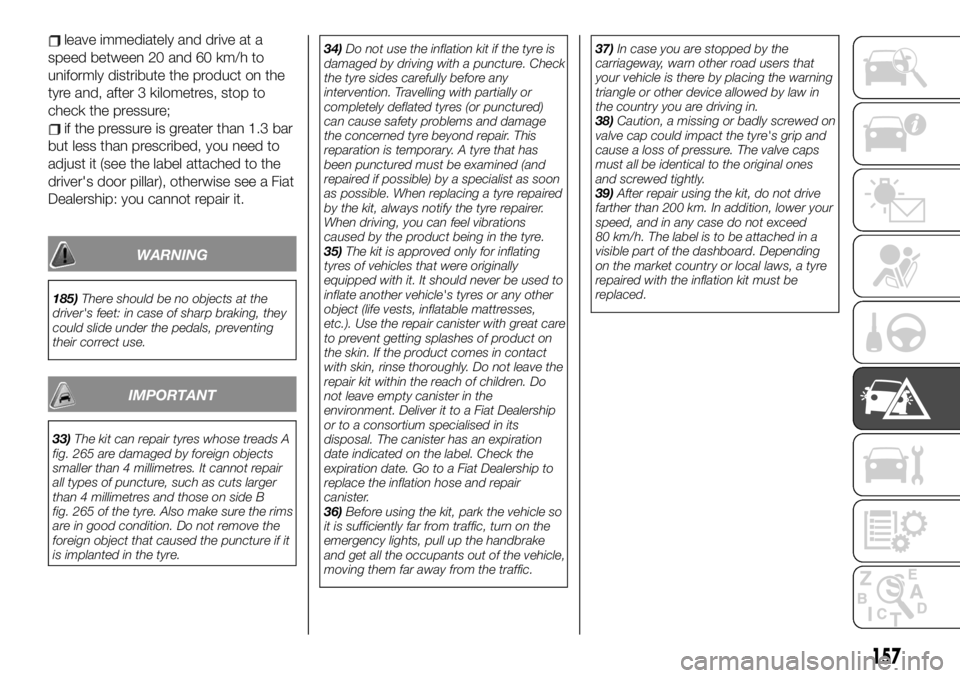
leave immediately and drive at a
speed between 20 and 60 km/h to
uniformly distribute the product on the
tyre and, after 3 kilometres, stop to
check the pressure;
if the pressure is greater than 1.3 bar
but less than prescribed, you need to
adjust it (see the label attached to the
driver's door pillar), otherwise see a Fiat
Dealership: you cannot repair it.
WARNING
185)There should be no objects at the
driver's feet: in case of sharp braking, they
could slide under the pedals, preventing
their correct use.
IMPORTANT
33)The kit can repair tyres whose treads A
fig. 265 are damaged by foreign objects
smaller than 4 millimetres. It cannot repair
all types of puncture, such as cuts larger
than 4 millimetres and those on side B
fig. 265 of the tyre. Also make sure the rims
are in good condition. Do not remove the
foreign object that caused the puncture if it
is implanted in the tyre.34)Do not use the inflation kit if the tyre is
damaged by driving with a puncture. Check
the tyre sides carefully before any
intervention. Travelling with partially or
completely deflated tyres (or punctured)
can cause safety problems and damage
the concerned tyre beyond repair. This
reparation is temporary. A tyre that has
been punctured must be examined (and
repaired if possible) by a specialist as soon
as possible. When replacing a tyre repaired
by the kit, always notify the tyre repairer.
When driving, you can feel vibrations
caused by the product being in the tyre.
35)The kit is approved only for inflating
tyres of vehicles that were originally
equipped with it. It should never be used to
inflate another vehicle's tyres or any other
object (life vests, inflatable mattresses,
etc.). Use the repair canister with great care
to prevent getting splashes of product on
the skin. If the product comes in contact
with skin, rinse thoroughly. Do not leave the
repair kit within the reach of children. Do
not leave empty canister in the
environment. Deliver it to a Fiat Dealership
or to a consortium specialised in its
disposal. The canister has an expiration
date indicated on the label. Check the
expiration date. Go to a Fiat Dealership to
replace the inflation hose and repair
canister.
36)Before using the kit, park the vehicle so
it is sufficiently far from traffic, turn on the
emergency lights, pull up the handbrake
and get all the occupants out of the vehicle,
moving them far away from the traffic.37)In case you are stopped by the
carriageway, warn other road users that
your vehicle is there by placing the warning
triangle or other device allowed by law in
the country you are driving in.
38)Caution, a missing or badly screwed on
valve cap could impact the tyre's grip and
cause a loss of pressure. The valve caps
must all be identical to the original ones
and screwed tightly.
39)After repair using the kit, do not drive
farther than 200 km. In addition, lower your
speed, and in any case do not exceed
80 km/h. The label is to be attached in a
visible part of the dashboard. Depending
on the market country or local laws, a tyre
repaired with the inflation kit must be
replaced.
157
Page 166 of 236
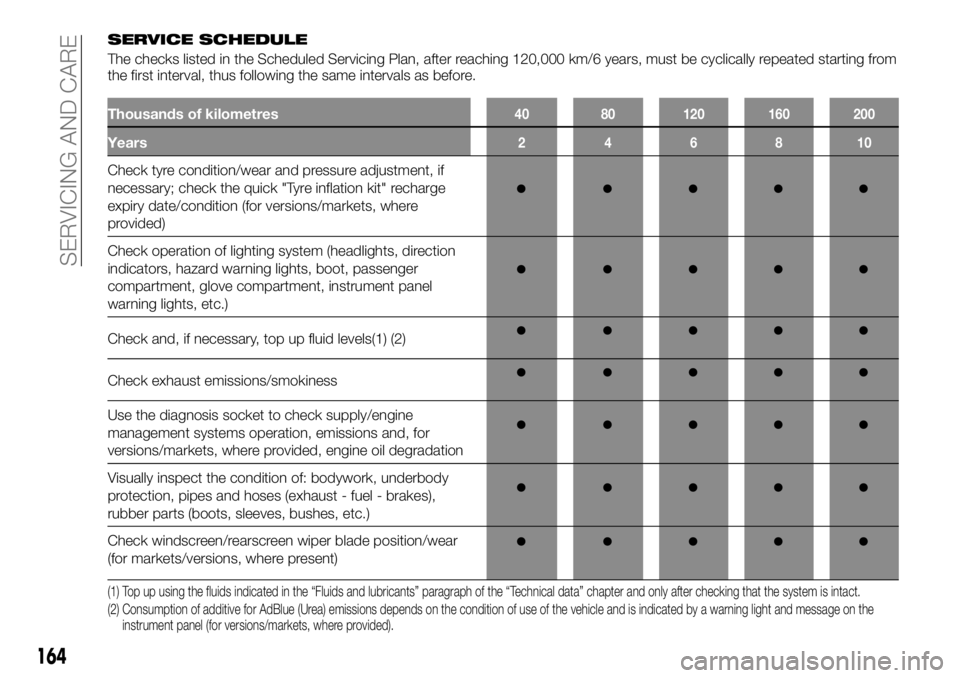
SERVICE SCHEDULE
The checks listed in the Scheduled Servicing Plan, after reaching 120,000 km/6 years, must be cyclically repeated starting from
the first interval, thus following the same intervals as before.
Thousands of kilometres40 80 120 160 200
Years246810
Check tyre condition/wear and pressure adjustment, if
necessary; check the quick "Tyre inflation kit" recharge
expiry date/condition (for versions/markets, where
provided)
Check operation of lighting system (headlights, direction
indicators, hazard warning lights, boot, passenger
compartment, glove compartment, instrument panel
warning lights, etc.)
Check and, if necessary, top up fluid levels(1) (2)
Check exhaust emissions/smokiness
Use the diagnosis socket to check supply/engine
management systems operation, emissions and, for
versions/markets, where provided, engine oil degradation
Visually inspect the condition of: bodywork, underbody
protection, pipes and hoses (exhaust - fuel - brakes),
rubber parts (boots, sleeves, bushes, etc.)
Check windscreen/rearscreen wiper blade position/wear
(for markets/versions, where present)
(1) Top up using the fluids indicated in the “Fluids and lubricants” paragraph of the “Technical data” chapter and only after checking that the system is intact.
(2) Consumption of additive for AdBlue (Urea) emissions depends on the condition of use of the vehicle and is indicated by a warning light and message onthe
instrument panel (for versions/markets, where provided).
164
SERVICING AND CARE
Page 170 of 236
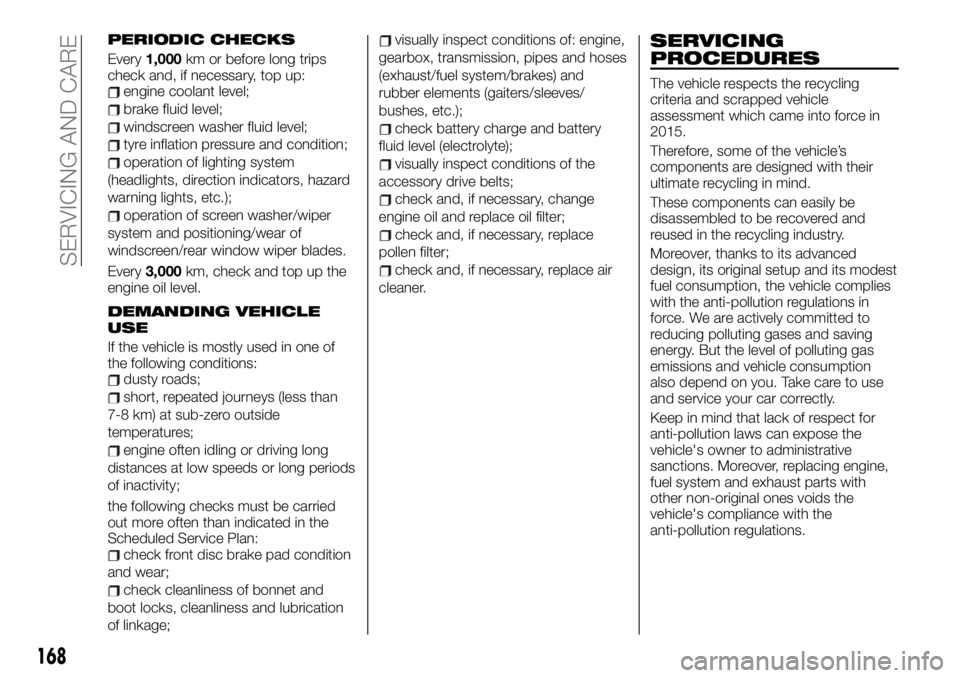
PERIODIC CHECKS
Every1,000km or before long trips
check and, if necessary, top up:
engine coolant level;
brake fluid level;
windscreen washer fluid level;
tyre inflation pressure and condition;
operation of lighting system
(headlights, direction indicators, hazard
warning lights, etc.);
operation of screen washer/wiper
system and positioning/wear of
windscreen/rear window wiper blades.
Every3,000km, check and top up the
engine oil level.
DEMANDING VEHICLE
USE
If the vehicle is mostly used in one of
the following conditions:
dusty roads;
short, repeated journeys (less than
7-8 km) at sub-zero outside
temperatures;
engine often idling or driving long
distances at low speeds or long periods
of inactivity;
the following checks must be carried
out more often than indicated in the
Scheduled Service Plan:
check front disc brake pad condition
and wear;
check cleanliness of bonnet and
boot locks, cleanliness and lubrication
of linkage;
visually inspect conditions of: engine,
gearbox, transmission, pipes and hoses
(exhaust/fuel system/brakes) and
rubber elements (gaiters/sleeves/
bushes, etc.);
check battery charge and battery
fluid level (electrolyte);
visually inspect conditions of the
accessory drive belts;
check and, if necessary, change
engine oil and replace oil filter;
check and, if necessary, replace
pollen filter;
check and, if necessary, replace air
cleaner.
SERVICING
PROCEDURES
The vehicle respects the recycling
criteria and scrapped vehicle
assessment which came into force in
2015.
Therefore, some of the vehicle’s
components are designed with their
ultimate recycling in mind.
These components can easily be
disassembled to be recovered and
reused in the recycling industry.
Moreover, thanks to its advanced
design, its original setup and its modest
fuel consumption, the vehicle complies
with the anti-pollution regulations in
force. We are actively committed to
reducing polluting gases and saving
energy. But the level of polluting gas
emissions and vehicle consumption
also depend on you. Take care to use
and service your car correctly.
Keep in mind that lack of respect for
anti-pollution laws can expose the
vehicle's owner to administrative
sanctions. Moreover, replacing engine,
fuel system and exhaust parts with
other non-original ones voids the
vehicle's compliance with the
anti-pollution regulations.
168
SERVICING AND CARE
Page 176 of 236
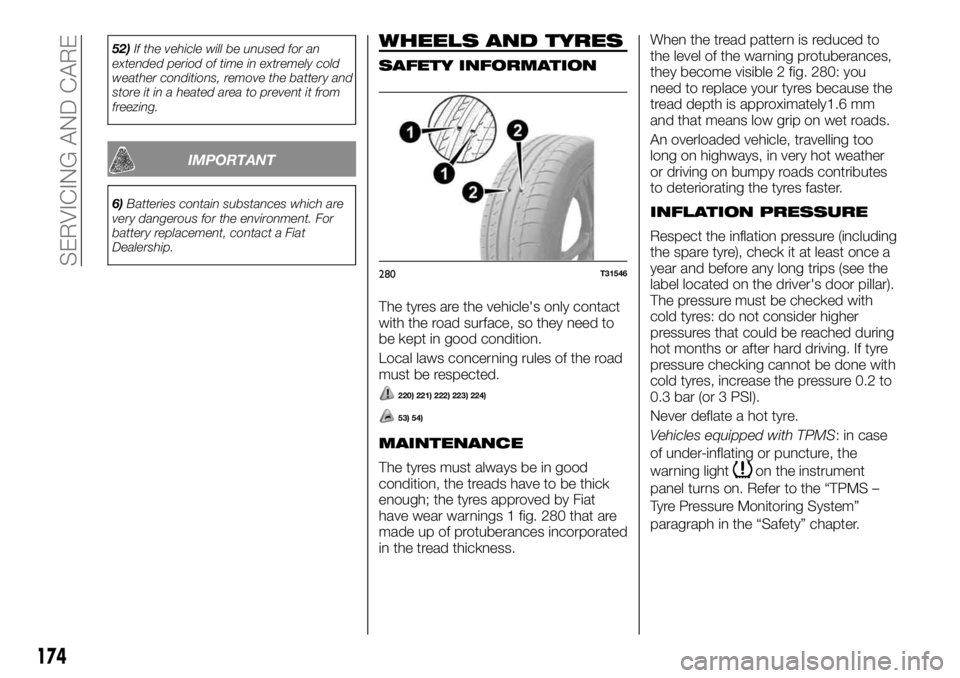
52)If the vehicle will be unused for an
extended period of time in extremely cold
weather conditions, remove the battery and
store it in a heated area to prevent it from
freezing.
IMPORTANT
6)Batteries contain substances which are
very dangerous for the environment. For
battery replacement, contact a Fiat
Dealership.
WHEELS AND TYRES
SAFETY INFORMATION
The tyres are the vehicle's only contact
with the road surface, so they need to
be kept in good condition.
Local laws concerning rules of the road
must be respected.
220) 221) 222) 223) 224)
53) 54)
MAINTENANCE
The tyres must always be in good
condition, the treads have to be thick
enough; the tyres approved by Fiat
have wear warnings 1 fig. 280 that are
made up of protuberances incorporated
in the tread thickness.When the tread pattern is reduced to
the level of the warning protuberances,
they become visible 2 fig. 280: you
need to replace your tyres because the
tread depth is approximately1.6 mm
and that means low grip on wet roads.
An overloaded vehicle, travelling too
long on highways, in very hot weather
or driving on bumpy roads contributes
to deteriorating the tyres faster.
INFLATION PRESSURE
Respect the inflation pressure (including
the spare tyre), check it at least once a
year and before any long trips (see the
label located on the driver's door pillar).
The pressure must be checked with
cold tyres: do not consider higher
pressures that could be reached during
hot months or after hard driving. If tyre
pressure checking cannot be done with
cold tyres, increase the pressure 0.2 to
0.3 bar (or 3 PSI).
Never deflate a hot tyre.
Vehicles equipped with TPMS: in case
of under-inflating or puncture, the
warning light
on the instrument
panel turns on. Refer to the “TPMS –
Tyre Pressure Monitoring System”
paragraph in the “Safety” chapter.
280T31546
174
SERVICING AND CARE
Page 177 of 236
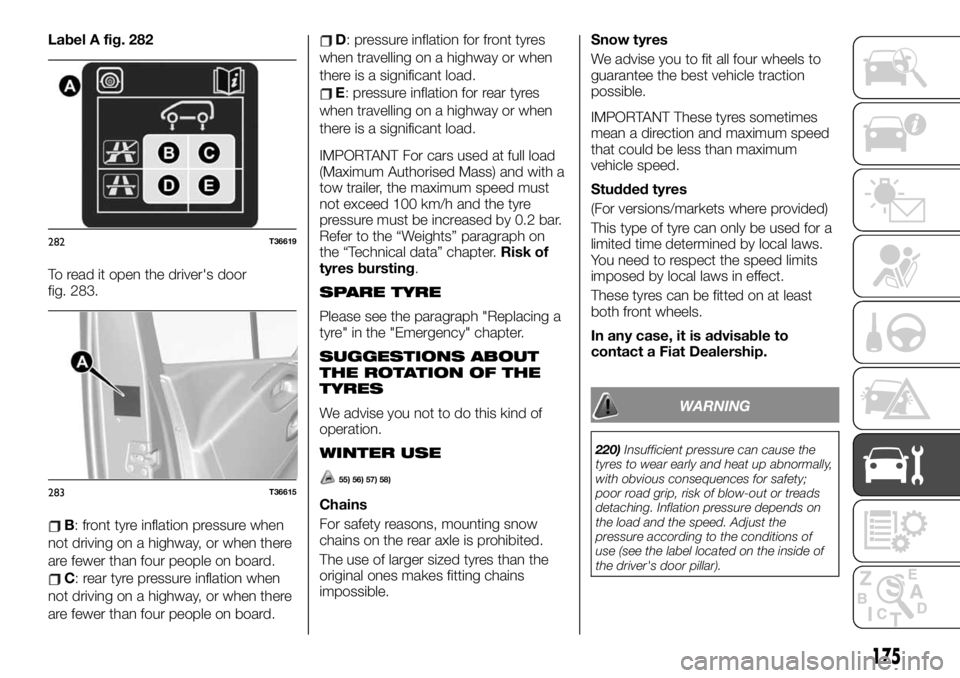
Label A fig. 282
To read it open the driver's door
fig. 283.
B: front tyre inflation pressure when
not driving on a highway, or when there
are fewer than four people on board.
C: rear tyre pressure inflation when
not driving on a highway, or when there
are fewer than four people on board.
D: pressure inflation for front tyres
when travelling on a highway or when
there is a significant load.
E: pressure inflation for rear tyres
when travelling on a highway or when
there is a significant load.
IMPORTANT For cars used at full load
(Maximum Authorised Mass) and with a
tow trailer, the maximum speed must
not exceed 100 km/h and the tyre
pressure must be increased by 0.2 bar.
Refer to the “Weights” paragraph on
the “Technical data” chapter.Risk of
tyres bursting.
SPARE TYRE
Please see the paragraph "Replacing a
tyre" in the "Emergency" chapter.
SUGGESTIONS ABOUT
THE ROTATION OF THE
TYRES
We advise you not to do this kind of
operation.
WINTER USE
55) 56) 57) 58)
Chains
For safety reasons, mounting snow
chains on the rear axle is prohibited.
The use of larger sized tyres than the
original ones makes fitting chains
impossible.Snow tyres
We advise you to fit all four wheels to
guarantee the best vehicle traction
possible.
IMPORTANT These tyres sometimes
mean a direction and maximum speed
that could be less than maximum
vehicle speed.
Studded tyres
(For versions/markets where provided)
This type of tyre can only be used for a
limited time determined by local laws.
You need to respect the speed limits
imposed by local laws in effect.
These tyres can be fitted on at least
both front wheels.
In any case, it is advisable to
contact a Fiat Dealership.
WARNING
220)Insufficient pressure can cause the
tyres to wear early and heat up abnormally,
with obvious consequences for safety;
poor road grip, risk of blow-out or treads
detaching. Inflation pressure depends on
the load and the speed. Adjust the
pressure according to the conditions of
use (see the label located on the inside of
the driver's door pillar).
282T36619
283T36615
175